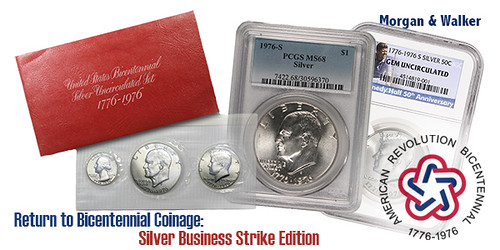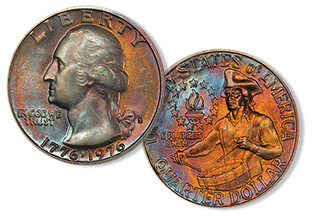
PREV ARTICLE
NEXT ARTICLE
FULL ISSUE
PREV FULL ISSUE
THE 1976 U.S. BICENTENNIAL COINAGE
Charles Morgan and Hubert Walker of CoinWeek published a nice article March 3, 2017 on the U.S. Bicentennial coinage. here's an excerpt.
-Editor

One of the first pieces that we wrote for CoinWeek discussed Bicentennial quarters. In it, we discussed the nuances of the issue, from strike to Mint State grade distribution of the P- and D-mint coins by PCGS and NGC. We also questioned whether the coin would ever see an appreciable rise in value (spoiler alert: it hasn’t yet). Regardless, when we wrote it, we felt that modern coin collectors would benefit from the kind of in-depth analysis that is generally reserved for “investment-grade” classic numismatic coins. Today, we’d like to return to the topic of America’s Bicentennial coinage and discuss the silver-clad three coin Uncirculated set - a perennial favorite for collectors of modern U.S. coins. The Bicentennial Silver Three-Coin Uncirculated Set was struck starting in February 1975 and continuing through to June 22, 1976, according to Walter Breen. Q. David Bowers writes in his A Guide Book of Modern United States Dollar Coins that federal law required the U.S. Mint to be finished with silver Bicentennial coin production by July 4 of that year. As the production window closed, the Mint (expecting huge demand) made the decision to dramatically increase the number of sets made by running the coins through at high speed. They probably shouldn’t have bothered; it is estimated that of the 11 million sets produced, only 4,908,319 sets were sold.
Two Types of Collector Demand
For raw coins, grade on uncirculated coins in original mint packaging (or even broken up and put in individual after-market coin flips or 2x2s) is of little consequence. Collectors typically prefer coins with good eye appeal, but will generally accept a complete set in its original packaging as sufficient for their needs. To this type of collecting, a Bicentennial Silver Three-Coin Uncirculated has a value of whatever the prevailing market price is for a complete set. In other words, $13-$14, based on today’s market price. For collectors who prefer certified coins, the “value” of the sets is much more nuanced because the goals of this collector are markedly different. Certified coin collectors seek to commoditize quality.
As a young collector I bought these sets directly from the Mint. I liked the coins then, and still do today. My favorite is the Jack Ahr drummer quarter, and I'm pleased to see these still in circulation today. With over 1.4 billion minted it'll never be a rare coin, but that's no reason not to collect them or seek out the best possible specimens.
-Editor
To read the complete article, see:
For more information on Jack Ahr and his quarter, see: Jack Ahr Design, Inc. (www.jackahrdesign.com/TheBicentennialQuarter/) 
Wayne Homren, Editor The Numismatic Bibliomania Society is a non-profit organization promoting numismatic literature. See our web site at coinbooks.org. To submit items for publication in The E-Sylum, write to the Editor at this address: whomren@gmail.com To subscribe go to: https://my.binhost.com/lists/listinfo/esylum All Rights Reserved. NBS Home Page Contact the NBS webmaster 
|
